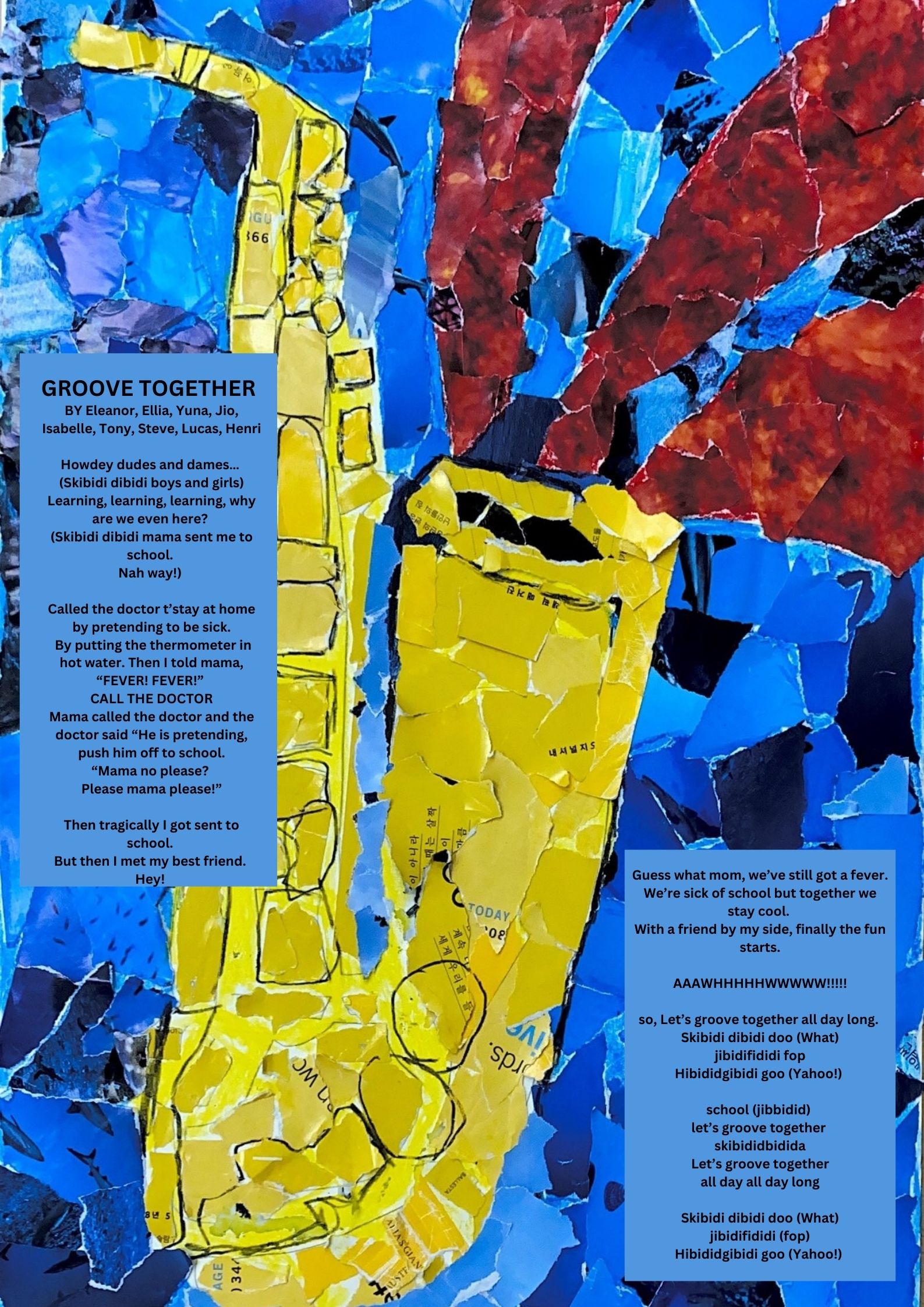UME
Pop Music
By Tania, Ryan, Janice, Lucy, Jake, Sofia, Star, Daniel, Dain
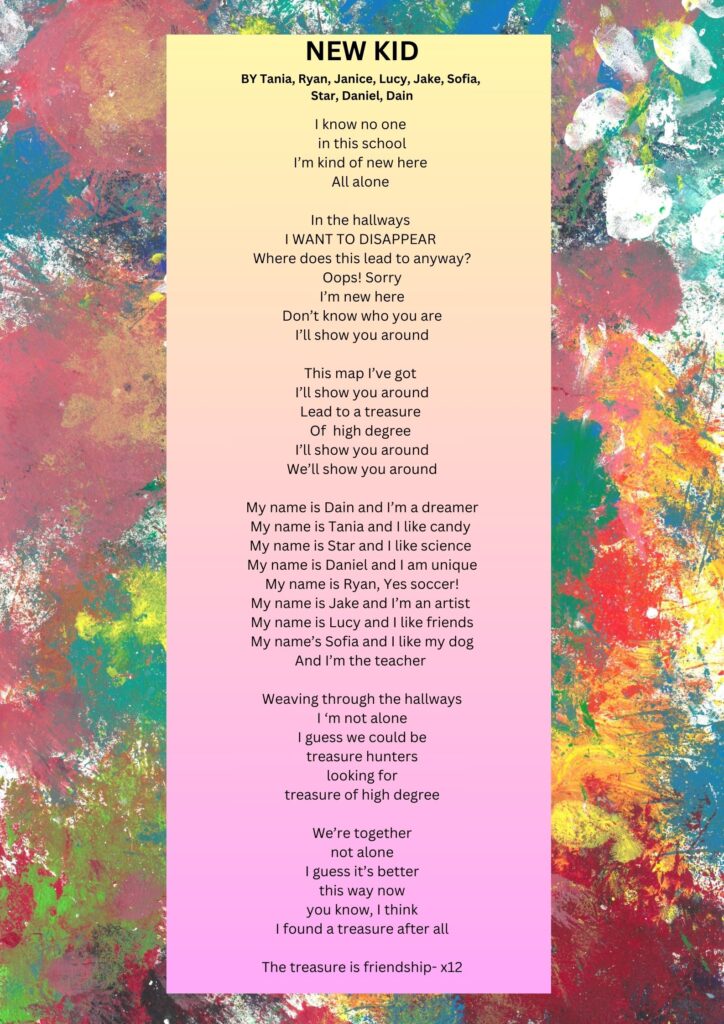
Music video https://youtu.be/aCEkqw0ekUM

What is Pop Music?
Group 1 Suh, YuJu(Bella), Ji, YuBin(YuBin), Han, ChaeWoo(Steve)
“Pop” is short for the word “popular.” Pop music is the genre of music that produces the most hits. A hit is a song that sells many copies, or is very popular. The latest hits are listed every week on the top charts. To get on the charts, a song must be released as a single, although most singles are also released on an album.
Songs that become hits almost always have certain features that are sometimes called the pop-music formula. They have a good rhythm, a catchy melody, and are easy to remember and sing along to. They usually have a chorus that is repeated several times, and two or more verses. Most pop songs are between two and five minutes long, and the lyrics are usually about the joys and problems of love and relationships.
Origins of Pop Music
Group 2 Kim, KyuRin(Lina), Jung, GaIn(Lena), Han, InHo(Inho)
Pop music is a genre of popular music that started in the mid 1950s in the United States and the United Kingdom. During this time, pop music was mostly rock and roll. Rock and pop remained synonymous until the late 1960s, after which pop became more commercial.
Pop music grew out of light entertainment and easy listening tradition. It was more conservative than other genres at the time, such as folk, blues, and country music. Most pop songs do not contain themes of resistance, opposition, or political themes, rather focusing more on love and relationships.
In the 1800s, Stephan Foster was the first writer of songs that were recognized as pop tunes. They would later be performed by artists ranging from Nat King Cole to the Beatles, without anyone knowing the songs were more than 100 years old!
The Evolution of Pop Music
Group 3 Jang, HyukJae(Jeff), Ko, DongHyun(Derek), Lee, SeoHee(Sally)
Many different styles of music have become pop music during different time periods. Music companies would create pop music by taking songs that few people listened to and making it popular.
In the 1950s, record companies turned blues-influenced rock and roll into pop music. In the late 1960s and early 1970s, they took folk music bands and musicians and helped to create music called folk rock or acid rock. In the 1970s, record companies created harder, louder types of blues called blues rock and heavy metal.
In the late 1970s to early 1980s, a type of nightclub dance music called disco became popular. In the 1990s, record companies took an underground type of hard rock called grunge and made it popular with bands like Nirvana and Pearl Jam. By the 21st century, boy and girl singing groups and contemporary R&B became mainstream pop music.
Michael Jackson was the most influential artist in pop music. His album Thriller is the best selling album of all time. He is known as the “King of Pop.”
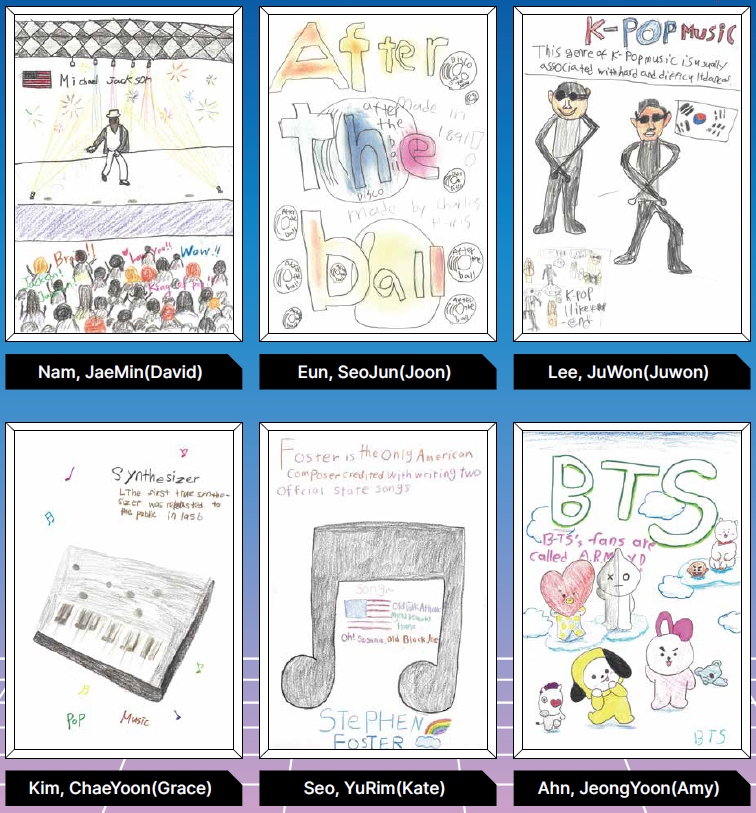
Presentation Video https://youtu.be/BbrqVhdkIrc
ROSE
Group A Eleanor, Ellia, Yuna, Jio, Isabelle, Tony, Lucas, Henri
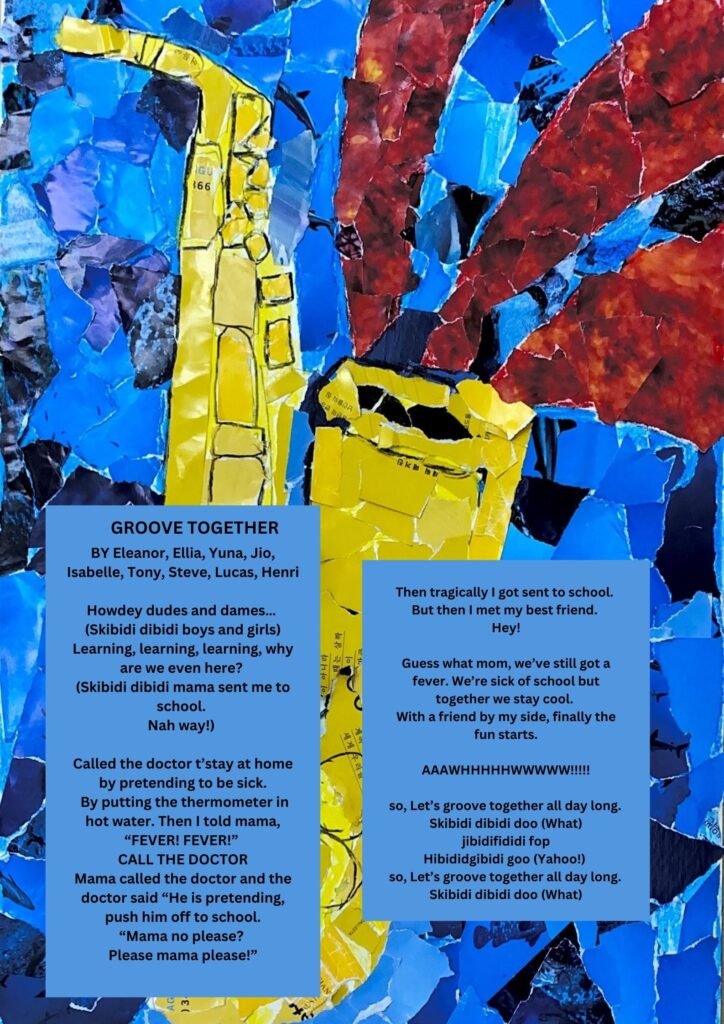
Music Video https://youtu.be/Trfry_RpCNI

What is Jazz Music?
Group 1 Lee, JuWon (Judith), Cho, HaNee (Hanee), Kim, MyoungSeo (Sera)
Jazz music is an American style of music. It evolved from various musical styles, and makes use of syncopated rhythms, improvisation, and polyphonic ensemble music. There is tremendous variety in jazz, but most jazz is very rhythmic, has a forward momentum called “swing,” and uses “bent” or “blue” notes. You can often hear “call-and-response” patterns in jazz, in which one instrument answers another.
Improvisation is typically an important part of jazz music. Improvisation in jazz music is depicted through the changing of melodies rhythmically, embellishment of the melodies, and the creation of solos in the moment of playing. In many jazz performances, musicians play solos that they make up on the spot, which requires considerable skill.
Jazz is often associated with freedom, and can express many different emotions, from pain to joy, from sorrow to happiness. It achieves this with changes in texture, tempo, and lyrics.
Origins of Jazz Music
Group 2 Park, SoHoo (Julian), Kim, ShinHo (Asher)
Jazz was created in the late 19th century by African-Americans in the city of New Orleans, located in the south. Slaves in New Orleans didn’t have to work on Sundays. They were also allowed to play the drums, unlike in other places. Many would gather to socialize at a place called Congo Square. Many of them would bring instruments and play with each other.
Early jazz was a combination of blues, ragtime, European harmony, and African rhythm. It also drew from Western classical music as well as African and slave folk songs. The recipe of life experiences and musical influences from Africa, the Caribbean, and America mixed into an amazing new genre. The excitement around the new sound began spreading, and the genre of jazz music really grew in New York City. The style of jazz has changed many times throughout the years.
Styles of Jazz Music
Group 3 Oh, JiHoon (James), Ahn, DoHyun (Daniel), Min, ByungHeon (Noel)
There are many different styles of jazz music. Swing jazz features danceable, swinging grooves. Bebop has complex harmonies, fast tempos, intricate melodies, and improvisation. Cool jazz is more relaxed and features a restrained style, focusing on smooth, cool tones. Hard bop combines bebop with elements of blues, gospel, and R&B. Free jazz is highly experimental and focuses on improvisation and a lack of predefined structures. Fusion jazz blends elements of jazz with other genres. Each style has its own unique characteristics.
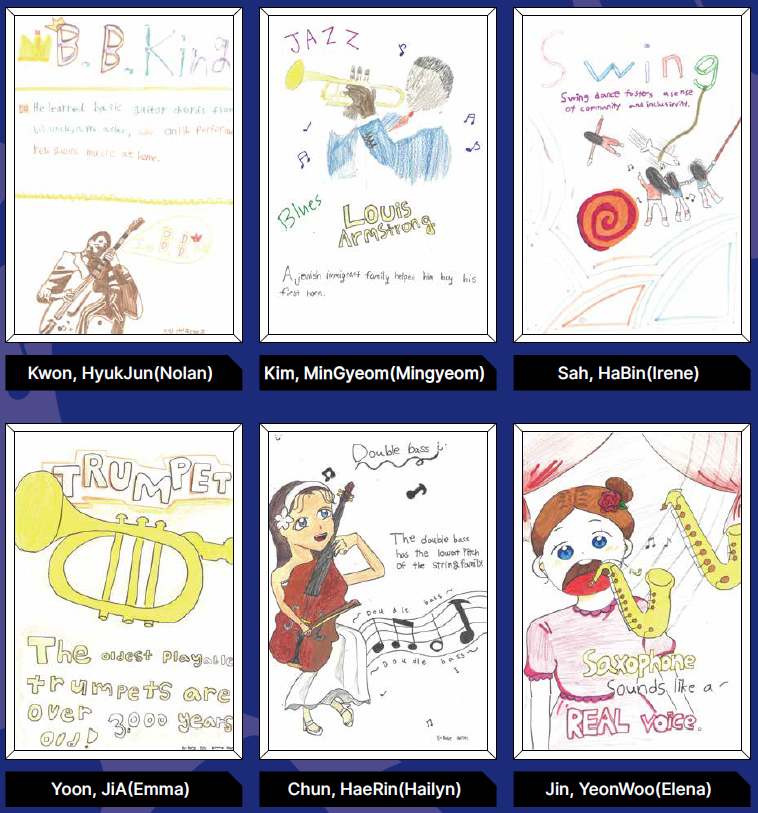
Presentation Video https://youtu.be/MTqY702_KWc
ORCHID
By Lucas, Ryan, Sean, Yoon, Danny, Jayden, Andy, Nora, Agnes

Music Video https://youtu.be/b8hoMkKMTKw

What is Rock Music?
Group 1 Lee, JunWoo(James), Lee, SeokJun(Max), Park, SeungGyun(William)
Rock and roll is a genre of popular music. Rock and roll mostly uses electric guitar, bass, drums, and saxophone for instruments. Rock music usually has a 4/4 beat, and songs typically have a verse-chorus form. As opposed to jazz, the drums and bass in rock usually lock in with each other and stick to a tight pattern. Guitar is the signature instrument of rock music. The genre is known for using power chords, distortion, and amazing guitar solos.
First, rock and roll was only popular with African-Americans, but in the 1950s-1960s, rock and roll became popular across the U.S. and in Europe. By the mid-1960s, rock and roll had developed into the more encompassing international style known as rock music.
Origins of Rock Music
Group 2 Ahn, ChaeWon(Alice), Cho, SuA(Emma), Woo, DaHye(Isabel)
Rock and roll is a genre of popular music that evolved in the United States during the late 1940s and early 1950s. It originated from African-American music such as jazz, rhythm and blues, gospel, even country music. Most of the major early rock and roll acts started in the southern United States. Their music combined African musical tradition with Western instruments, like the guitar. It is a genre that was born by changing the 12-bar blues into a violent and decadent dance rhythm. Rock and roll quickly became popular across the United States and in Europe. Its popularity grew naturally as it provided a release for many young people in an economically and socially rigid society.
Styles of Rock Music
Group 3 Son, JiWoo(Gisele), Kim, JiWoo(Alice), Hwang, Eugenie(Eugenie)
There are many different styles of rock music. Blues rock sounds sad, and relies on the chords, scales, and instrumental improvisation of blues. Hard rock is a more fun and heavier subgenre of rock music, typically with aggressive vocals and distorted electric guitars. Metal music is usually heavier, specifically in the extreme subgenres of death and black metal. Punk rock produced short, fast-paced songs with fun melodies and simple instrumentation. In contrast, progressive rock is more experimental and adventurous. It abandons standard pop traditions in favor of instrumentation and compositional techniques more frequently associated with jazz, folk, or classical music.
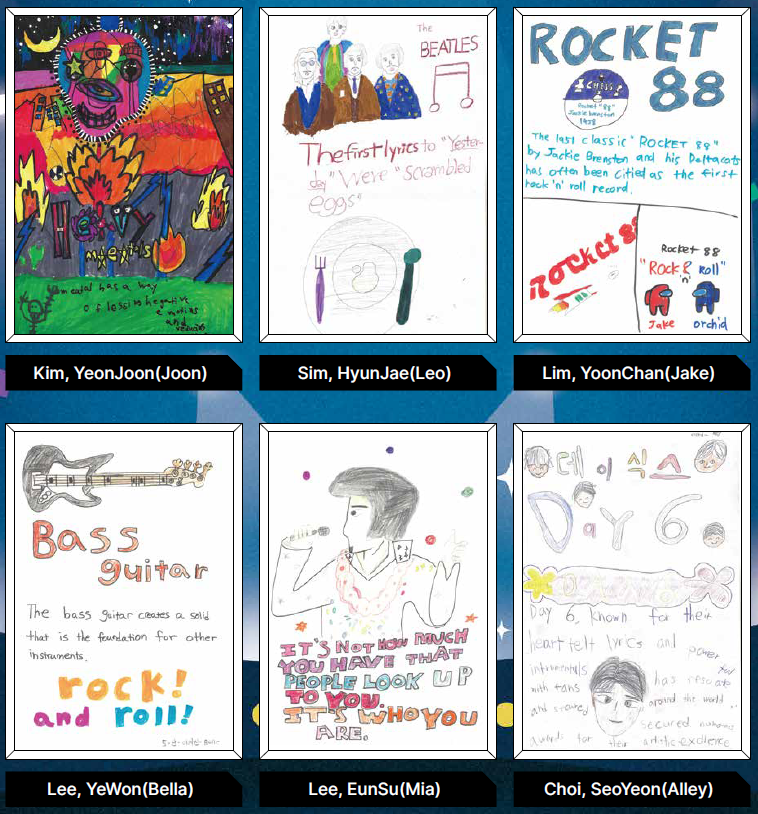
Presentation Video https://youtu.be/gS3T53mXI1A
PEONY
By Emily, Emma, Ellie, Summer, June, Paul, Seyoon, Luna
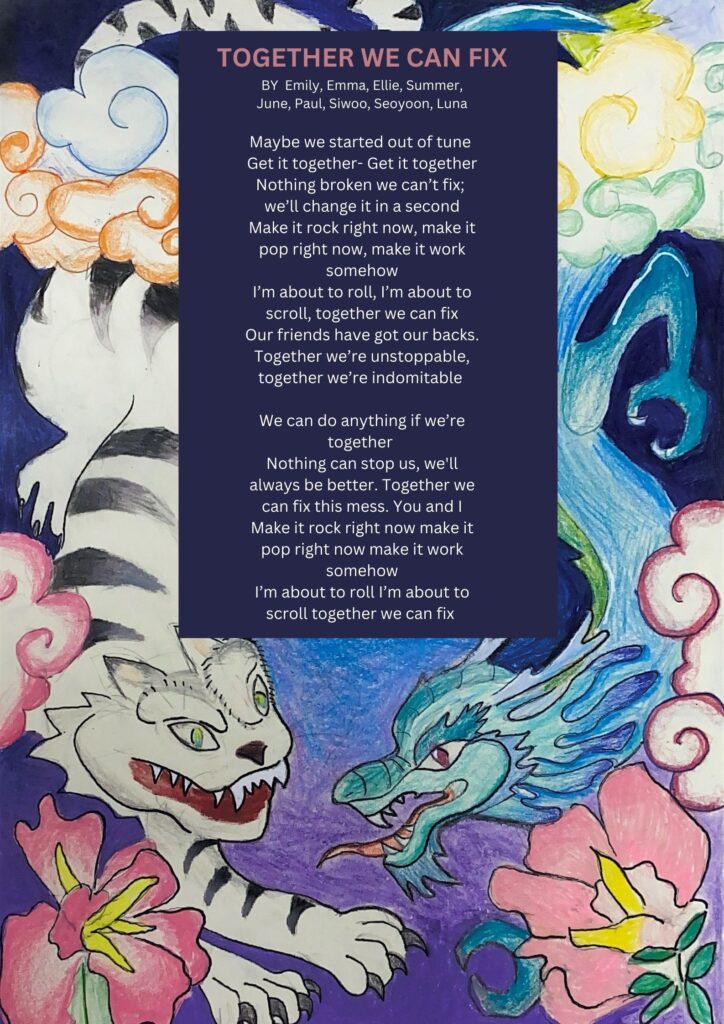
Music Video https://youtu.be/JyJFU5P2p3I

What is Folk Music?
Group 1 Kwon, DongHyun(Eugene), Choi, SeungWoo(Kevin), Kim, GyuHyun(Teddy)
Folk music is a genre of traditional music that typically originates from a particular culture or region. It’s passed down orally from generation to generation, often reflecting the history, values, and experiences of a country or culture. One of the defining characteristics of folk music is its emphasis on storytelling. Many folk songs recount historical events, local legends, or everyday experiences of ordinary people.
As folk music gets passed down through generations, it evolves with the changing times while still keeping its authenticity. It has the ability to bring people together and create a sense of community. It is often played at social gatherings, festivals, and other events where people can come together. Folk music has deep roots in many different cultures around the world. Each one has its own unique style.
Korean Folk Music
Group 2 Kang, JiWoo(Sophie), Kim, SeoYun(Ella), Park, GeeYu(Geeyu)
Korean folk music, known as minyo in Korean, is a vibrant and diverse tradition that reflects the cultural heritage of Korea. It includes many different musical forms, including vocal music, instrumental music, and dance. Korean folk music differs greatly across regions in Korea. Each region has its own unique styles, melodies, and rhythms, shaped by local traditions, history, and environment. Some famous songs are the central Arirang, the southwestern Yukchabaegi, and the northwestern Sushimga. Korean music can be traced to the fifth century, and has been well documented since the fifteenth century,
Traditional Korean musical instruments play a crucial role in folk music. Some of the most commonly used instruments include the gayageum (a zither with 12 strings), the geomungo (a larger zither with 6 strings), the daegeum (a large bamboo flute), the haegeum (a two-stringed fiddle), and various percussion instruments like the janggu (hourglass-shaped drum) and the buk (a barrel drum).
Styles of Korean Folk Music
Group 3 Kim, ManSun(Joy), Woo, DaHyeon(Cindy), Jeong, SeYeong(SeYeong)
Korean folk music ranges from what ordinary people play and sing to highly professional music. What holds in together is a consistent and easily recognizable set of rhythmic patterns and a less well-defined set of melodies. Korean court music is mostly orchestral, highly refined, and an acquired taste. But it has a majesty and integrity all its own, and a very long heritage dating back to the Joseon Dynasty (1392-1910). Court music was originally divided into Chinese ritual music (introduced to Korea in 1116), Koreanized music of Chinese origin, and indigenous Korean music.
Korean religious music comes from shamanistic and Buddhist traditions. Shamanistic music comes in two main forms: vocal chanting of texts (muga) and instrumental improvisation. Traditional Buddhist chants has three main types: long complex chants performed by highly trained singers, rapid chanting performed by monks and followers, and Korean folk-style music on Buddhist themes. Pansori is a type of Korean folk music performed by a single singer and drummer. The music presents a story with song, acting, and narration, and may continue for five or more hours. Sanjo is an instrumental form of Korean folk music. These days Korean folk music uses elements of many modern styles of music.
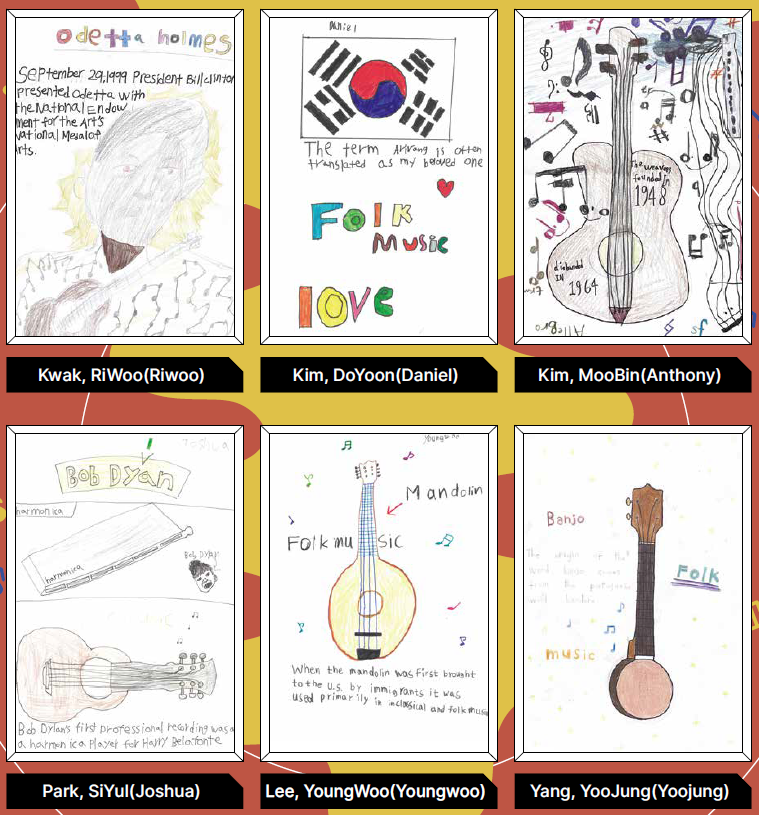
Presentation Video https://youtu.be/m2AI9SBIwu8

